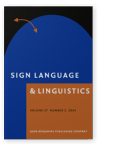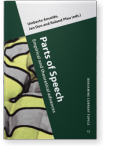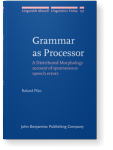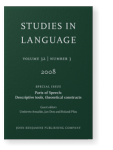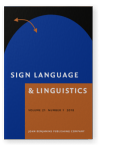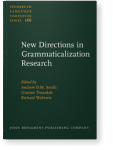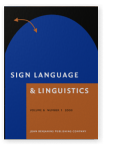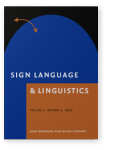Roland Pfau
List of John Benjamins publications for which Roland Pfau plays a role.
Journal
The Linguistics of Sign Languages: An introduction
Edited by Anne E. Baker, Beppie van den Bogaerde, Roland Pfau and Trude Schermer
[Not in series, 199] 2016. xv, 378 pp.
Subjects Signed languages | Theoretical linguistics
Parts of Speech: Empirical and theoretical advances
Edited by Umberto Ansaldo, Jan Don and Roland Pfau
[Benjamins Current Topics, 25] 2010. vi, 291 pp.
Subjects Syntax | Theoretical linguistics
Grammar as Processor: A Distributed Morphology account of spontaneous speech errors
Roland Pfau
[Linguistik Aktuell/Linguistics Today, 137] 2009. xiii, 372 pp.
Subjects Generative linguistics | Morphology | Psycholinguistics | Semantics | Syntax | Theoretical linguistics
Parts of Speech: Descriptive tools, theoretical constructs
Edited by Umberto Ansaldo, Jan Don and Roland Pfau
Special issue of Studies in Language 32:3 (2008) 246 pp.
Subjects Functional linguistics | Theoretical linguistics | Typology
2023 Chapter 2. Negative Concord in Sign Language of the Netherlands: A journey through a corpus Advances in Sign Language Corpus Linguistics, Wehrmeyer, Ella (ed.), pp. 30–65 | Chapter
In a Negative Concord (NC) configuration, two negative elements co-occur in a clause but the polarity of that clause still remains negative. NC involving two manual negators has been observed in various sign languages, but relevant examples are usually presented in the context of broader… read more
2018 A negation-tense interaction in Georgian Sign Language Sign Language & Linguistics 21:1, pp. 137–151 | To be specified
We describe an intriguing interaction of negation and tense in Georgian Sign Language (GESL), a sign language which to date has received close to no attention by linguists. GESL verbs that employ an irregular negation strategy in the present tense (modal verbs and the verb know) require double… read more
2016 Constituents and word classes The Linguistics of Sign Languages: An introduction, Baker, Anne E., Beppie van den Bogaerde, Roland Pfau and Trude Schermer (eds.), pp. 93–115 | Article
2016 Foreword The Linguistics of Sign Languages: An introduction, Baker, Anne E., Beppie van den Bogaerde, Roland Pfau and Trude Schermer (eds.), pp. xiii–xv | Foreword
2016 Morphology The Linguistics of Sign Languages: An introduction, Baker, Anne E., Beppie van den Bogaerde, Roland Pfau and Trude Schermer (eds.), pp. 197–228 | Article
2016 Syntax: complex sentences The Linguistics of Sign Languages: An introduction, Baker, Anne E., Beppie van den Bogaerde, Roland Pfau and Trude Schermer (eds.), pp. 149–172 | Article
2016 Syntax: simple sentences The Linguistics of Sign Languages: An introduction, Baker, Anne E., Beppie van den Bogaerde, Roland Pfau and Trude Schermer (eds.), pp. 117–147 | Article
2016 Language contact and change The Linguistics of Sign Languages: An introduction, Baker, Anne E., Beppie van den Bogaerde, Roland Pfau and Trude Schermer (eds.), pp. 299–324 | Article
2016 Psycholinguistics The Linguistics of Sign Languages: An introduction, Baker, Anne E., Beppie van den Bogaerde, Roland Pfau and Trude Schermer (eds.), pp. 25–50 | Article
2015 The grammaticalization of headshakes: From head movement to negative head New Directions in Grammaticalization Research, Smith, Andrew D.M., Graeme Trousdale and Richard Waltereit (eds.), pp. 9–50 | Article
All sign languages investigated to date make use of a side-to-side headshake in the context of negation. This headshake, however, is qualitatively different from the co-speech gesture used by speakers in similar contexts. Following a discussion of the origin and use of gestural headshakes, we show… read more
2015 PERSON climbing up a tree: (and other adventures in sign language grammaticalization) Signs and Structures: Formal Approaches to Sign Language Syntax, Rutkowski, Paweł (ed.), pp. 71–101 | Article
Studies on sign language grammaticalization have demonstrated that most of the attested diachronic changes from lexical to functional elements parallel those previously described for spoken languages. To date, most of these studies are either descriptive in nature or embedded within… read more
2013 person climbing up a tree: (and other adventures in sign language grammaticalization) Sign Language Syntax from a Formal Perspective: Selected Papers from the 2012 Warsaw FEAST, Rutkowski, Paweł (ed.), pp. 189–220 | Article
Studies on sign language grammaticalization have demonstrated that most of the attested diachronic changes from lexical to functional elements parallel those previously described for spoken languages. To date, most of these studies are either descriptive in nature or embedded within… read more
2010 Parts-of-Speech: Particulars, universals and theoretical constructs Parts of Speech: Empirical and theoretical advances, Ansaldo, Umberto, Jan Don and Roland Pfau (eds.), pp. 1–4 | Article
2008 Parts of Speech: Particulars, universals and theoretical constructs Parts of Speech: Descriptive tools, theoretical constructs, Ansaldo, Umberto, Jan Don and Roland Pfau (eds.), pp. 505–508 | Article
2003 Optimal reciprocals in German Sign Language Sign Language & Linguistics 6:1, pp. 3–42 | Article
Unlike most spoken languages, German Sign Language (DGS) does not have a single means of reciprocal marking. Rather, different strategies are used, which crucially depend on phonological (one-handed sign vs. two-handed sign) and morphosyntactic (plain verb vs. agreement verb) properties of the… read more
2002 Review of Erlenkamp (2000): Syntaktische Kategorien und lexikalische Klassen Sign Language & Linguistics 5:2, pp. 247–253 | Review
